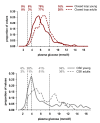Closed-loop insulin delivery for treatment of type 1 diabetes
- PMID: 22071283
- PMCID: PMC3229449
- DOI: 10.1186/1741-7015-9-120
Closed-loop insulin delivery for treatment of type 1 diabetes
Abstract
Type 1 diabetes is one of the most common endocrine problems in childhood and adolescence, and remains a serious chronic disorder with increased morbidity and mortality, and reduced quality of life. Technological innovations positively affect the management of type 1 diabetes. Closed-loop insulin delivery (artificial pancreas) is a recent medical innovation, aiming to reduce the risk of hypoglycemia while achieving tight control of glucose. Characterized by real-time glucose-responsive insulin administration, closed-loop systems combine glucose-sensing and insulin-delivery components. In the most viable and researched configuration, a disposable sensor measures interstitial glucose levels, which are fed into a control algorithm controlling delivery of a rapid-acting insulin analog into the subcutaneous tissue by an insulin pump. Research progress builds on an increasing use of insulin pumps and availability of glucose monitors. We review the current status of insulin delivery, focusing on clinical evaluations of closed-loop systems. Future goals are outlined, and benefits and limitations of closed-loop therapy contrasted. The clinical utility of these systems is constrained by inaccuracies in glucose sensing, inter- and intra-patient variability, and delays due to absorption of insulin from the subcutaneous tissue, all of which are being gradually addressed.
Figures


References
-
- Diabetes Control and Complication Trial Study Group (DCCT) The effect of intensive treatment of diabetes on the development and progression of long-term complications in insulin-dependent diabetes-mellitus. N Engl J Med. 1993;329:977–986. - PubMed
Publication types
MeSH terms
Grants and funding
LinkOut - more resources
Full Text Sources
Other Literature Sources
Medical

